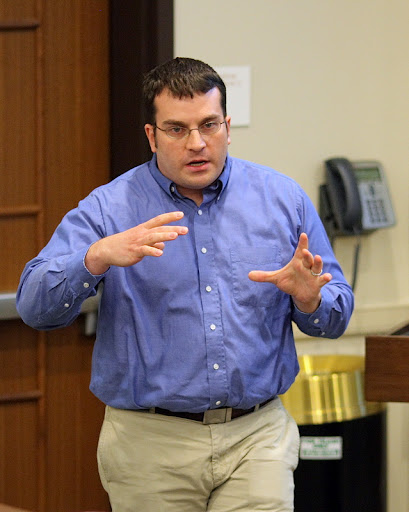 |
| 1955 Young Dick Weir receives first clue from God concerning energy storage. |
 |
| Dr. Pettey hand modeling paramagnetic & paraelectric properties. Source: Picasaweb |
Unfortunately for those who hate to relearn something, we have to update our model of EEStor operations to factor in the contributions of one of the former underlings, Dr. Lucas Pettey whose EEStor owned invention proposal has been disclosed today by our US Patent & Trademark office. This patent applications marks the first time we have seen an EEStor application sans Weir or Nelson. That's right, I said this application does not include Vice Admiral Dick Weir or Southpaw Carl Nelson as co-inventors.
So who is this guy who has endeavored to climb the EEStor mountain of knowledge to taste a sip of revolutionary energy storage? Lucas Richard Pettey. He is a base guitar playing 2008 PHD from the University of Texas where he was supervised by Robert Wyatt, the W.T. Doherty Professor of Chemistry. To understand Pettey, I examined his magister's background. Wyatt summarizes his own academic specialization thus:
My research in theoretical chemistry is focused upon two areas of chemical dynamics, including the quantum theory of chemical reactions and the theory of intramolecular energy transfer. In both of these areas, the main questions concern the flow of energy: where does it go, and how long does it take to get there. We are involved with both methods of development and with the application of new methods to problems of current experimental interest.
Under Wyatt's tutelage, Dr. Pettey penned a disseration titled, "Quantum Dynamics on Adaptive Grids: The Moving Boundary Truncation Method" which is another way of saying, "You have no idea what I am writing about. Here, buy one of my band's CD's instead." Nonetheless, I read this dissertation and came up with 23 nearly fatal objections to Pettey's central contention. Typically, I find about 80 or 90 of these in similar works and therefore, I declare Pettey a certifiable genius. Congratulations.
Back several years ago in August 2009, I got to ask Dr. Wyatt about Pettey's trifling away of time with EEStor. He thanked me for my interest but said he only possesses "superficial knowledge of what is going on at EEStor" which I would suggest means far less than whatever you very hopeful readers think it means. In fact, I would ask you to also politely refrain from bothering the good Professor Wyatt with annoying EEStor questions either in email, via phone or at conferences where you may bump into him. He doesn't owe you any information just because he knows better than most whether or not Pettey is insane or genius or both.
| Spectrometer |
Coating the composition modified barium titanate (CMBT) powders with a purified aluminum oxide film provides technical advantages. In particular, the coatings increase voltage breakdown capability of capacitors fabricated with coated powders. The aluminum oxide coating of the CMBT powders provides addition protection by limiting or significantly reducing the loss of oxygen from the body of the powders when voltage is applied to a capacitor that is fabricated using CMBT powders. The coated powders significantly reduce the transfer of mobile ions from the CMBT powders due to the excellent high resistance as indicated above that purified aluminum oxide layers provide. The coated powders provide particle-to-particle isolation such that, if particles touch in a glass or plastic matrix, the loss of relative permittivity due to dipole energy interaction between crystallites is limited. Maintaining the permittivity is provided by the high voltage breakdown and sealing capability of the aluminum oxide protective layer.
As I happen to be all about "maintaining permittivity," I'm going to issue a passing score to Pettey on this application and suggest you do the same.
Y_No is banned from commenting on this article. Thanks to EEStor Patent Finder, Mark.

No comments:
Post a Comment